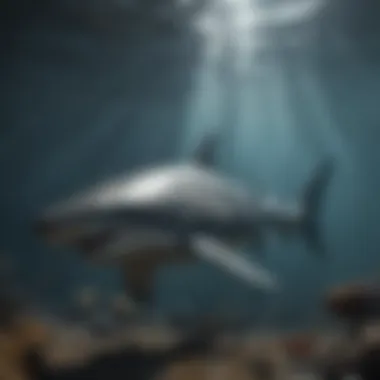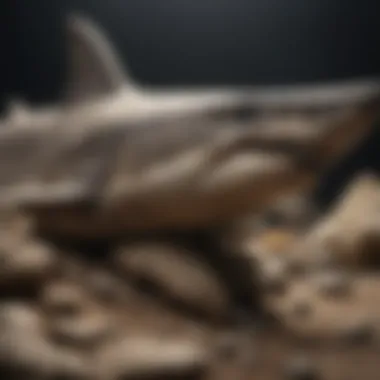Exploring Prehistoric Sharks: An In-depth Analysis


Intro
Prehistoric sharks represent an intriguing segment of the Earth's evolutionary history. These ancient creatures have fascinated scientists and enthusiasts alike due to their size, diversity, and adaptations over millions of years. Sharks date back to over 400 million years ago, significantly before the advent of dinosaurs. As such, exploring their evolution and significance can shed light on the broader narrative of marine life, both past and present.
This article aims to dissect the evolutionary journey of these remarkable beings, examining their anatomy, species differentiation, and the fossil records that document their existence. By doing so, it will provide insight for collectors, students, and anyone interested in natural history and paleontology.
History and Origins
Overview of Collectibles, Rocks, and Fossils
The study of prehistoric sharks is often closely tied to the analysis of fossils. Fossils are the remnants of ancient life preserved in sedimentary rock layers. Shark fossils commonly consist of teeth, as sharks have a unique anatomy that does not include bones. They shed teeth throughout their lives, leading to a plentiful fossil record.
Collecting shark teeth and other fossils is a popular activity among enthusiasts. Typically, collectors seek out sites that were once underwater, as these locations often yield a rich variety of fossils. Understanding geological eras, such as the Cretaceous and the Miocene, is essential for collectors to identify the age and significance of their finds. Knowledge of local rock formations can also guide enthusiasts in their pursuit of prehistorical treasures.
Historical Significance and Cultural Impact
Prehistoric sharks have not only contributed to our understanding of evolution but also influenced cultural narratives. The depiction of sharks in ancient art and folklore underscores their importance in human history. They have represented power, fear, and mystery across various cultures.
Moreover, recent paleontological discoveries continually enrich our understanding of these creatures. For example, fossils of the Megalodon, the largest shark known to exist, have captivated public interest and prompted discussions about extinction and ecological shifts.
"Fossils provide a glimpse into the past, offering a narrative of life that can change our understanding of evolution and survival."
Identification and Classification
Identifying and classifying prehistoric sharks can be complex due to the vast number of species and variations that have existed. However, recognizing the key characteristics can aid enthusiasts significantly.
Guide to Identifying Rocks and Fossils
When dissecting fossils, there are several crucial aspects to consider:
- Type of Fossil: Is it a tooth, vertebra, or an imprint?
- Shape and Size: What does it indicate about the species?
- Surface Texture: Is it smooth or rough, which can differ among species?
- Coloration: Certain fossils change color over time, informing collectors about their origin.
Common Types and Variations
The classification of prehistoric sharks can be categorized into several prominent groups:
- Megalodon: Known for its massive size.
- Great white ancestors: Related to modern-day great whites.
- Tiger sharks: Exhibiting unique tooth shapes and patterns.
- Hammerhead sharks: Recognizable for their distinctive head formation. Sifting through these variations offers an enriching avenue for collectors and enthusiasts, enhancing their appreciation for the complexity and diversity of prehistoric marine life.
Prelims to Prehistoric Sharks
Prehistoric sharks symbolize a profound chapter in the evolutionary tale of marine life. This section explores their significance, laying a foundation for understanding their role in the development of marine ecosystems. By studying these ancient creatures, one can appreciate not only their diversity but also their adaptability to changing environments over millions of years. Indicators of their success span from the distant past into modern ocean dynamics. Therefore, uncovering the characteristics and contributions of prehistoric sharks reveals much about the ongoing evolution of marine biology.
Defining Prehistoric Sharks
Prehistoric sharks encompass a wide range of species that existed long before modern times. They include both the ancestors of today's sharks and entirely unique forms that have since vanished. Defining these creatures involves recognizing their primary characteristics, which include their cartilaginous skeletons and specialized teeth adapted for predation. Unlike bony fish, the flexible structure of shark bodies allows them to take advantage of various ecological niches.
Prehistoric sharks are primarily identified through fossil records. Features like tooth morphology are critical for classification. For example, tooth shape can indicate the diet of the shark, revealing it as a predator or scavenger. Fossils have been discovered across continents, indicating a broad geographical distribution.
Importance in Marine Evolution
Understanding prehistoric sharks is essential for grasping the larger narrative of marine evolution. These creatures played a significant role as apex predators, influencing the evolutionary pathways of other marine species. They contributed to the stability of ancient ecosystems by maintaining balance within food webs. As top predators, their presence shaped the behavior and evolution of prey species, ensuring the development of diverse adaptations across marine life.
Furthermore, the study of prehistoric sharks informs current marine conservation efforts. By analyzing the extinction patterns of these creatures, scientists gain insights into the vulnerability of modern shark populations.
"The extinction of prehistoric sharks highlights the fragility of marine ecosystems and emphasizes the importance of conservation today."
In summary, prehistoric sharks not only mark significant moments in the history of life on Earth but also help illuminate pathways that are crucial for current scientific understanding of marine biodiversity. Understanding their legacy is vital for rock and fossil collectors and anyone intrigued by the deep history of our planet's oceans.
Historical Context
Understanding the historical context of prehistoric sharks is essential for grasping their evolutionary trajectory and ecological significance. This section will delve into critical aspects of the fossil records and highlight key geological eras where these giant predators thrived. This context enriches our knowledge about the diverse environments these sharks inhabited, as well as the biological and environmental factors that influenced their development and extinction.
Fossil Records and Discovery
Fossil records are vital for reconstructing the life history of prehistoric sharks. They provide direct evidence of the existence and diversity of these creatures over millions of years. Notably, scientists rely on sedimentary rocks containing shark teeth, fin spines, and even complete body fossils. These remnants enable researchers to analyze the morphology and geography of ancient marine environments.
The discovery of such fossils often occurs in specific locales worldwide. For instance, significant shark fossils have been uncovered in regions like the Chad Basin in Africa and various places across the United States including the south, where paleontologists have found a range of notable specimens. By studying these fossils, researchers gain insights not only into the species' characteristics but also into climate changes and shifts in oceanic ecosystems over time.
Additionally, the high variability of shark tooth forms can provide information about their diets, behavior, and adaptations. This layered understanding assists in piecing together the broader narrative of prehistoric marine life.
Key Geological Eras
Precambrian Period
The Precambrian Period sets the stage for life on Earth, encompassing a vast expanse of time from the formation of the planet until approximately 541 million years ago. During this era, the first multicellular organisms began to evolve. While sharks as we know them did not exist during this time, the origins of cartilaginous fish can be traced back to the late Precambrian. This period's significance lies in showcasing the foundational aspects of ocean life and revealing early environmental conditions that would eventually lead to the emergence of sharks.
One key characteristic of the Precambrian is the development of simple life forms, including algae and early protozoans. These organisms played a critical role in oxygenating the atmosphere and oceans, paving the way for more complex marine life. The advantage of discussing the Precambrian in this article underscores its role as a precursor to future evolutionary upheavals.
Paleozoic Era


The Paleozoic Era, spanning from about 541 to 252 million years ago, witnessed numerous significant events pertinent to sharks. Key developments during this era included the rise of fish in marine ecosystems, with early types of sharks appearing in the late Devonian period. Noteworthy within this era is the diversification of fish species, including the emergence of the first jawed fishes, which would later give rise to various shark lineages.
The Paleozoic Era is essential for understanding the adaptation and evolutionary milestones that defined early sharks. The unique feature of this era is the explosion of marine biodiversity known as the Cambrian Explosion. This event generated numerous ecological niches, helping sharks evolve into effective predators. A detailed examination of the Paleozoic aids in grasping the evolutionary roots of sharks and their successful adaptations.
Mesozoic Era
The Mesozoic Era is often referred to as the age of dinosaurs, but it was also critical for the evolution of sharks. This era, lasting from approximately 252 to 66 million years ago, saw the emergence and dominance of modern sharks. They evolved unique anatomical features and refined predatory skills. The key characteristic of this time is the significant diversification of marine life and the development of complex food webs.
Moreover, during the Cretaceous period, giant sharks like the famous Carcharocles megalodon began to populate oceans. The presence of such formidable species illustrates the adaptive versatility of sharks, showcasing their evolutionary resilience and dominance in varying marine environments. The Mesozoic Era serves as a turning point, making it an essential focus of this article.
Cenozoic Era
The Cenozoic Era, which began around 66 million years ago and continues to the present, marked the rise of mammals and the development of modern sharks. Noteworthy is the ecological shift that occurred after the Cretaceous-Paleogene extinction event, which eliminated many dominant species, including land dinosaurs. In this new ecological landscape, sharks adapted to fill various ecological roles, leading to the evolution of contemporary shark species.
A key characteristic of the Cenozoic Era is its climatic variability, which led to the development of temperate marine environments. This period highlights how sharks adapted to changing ecological conditions. The unique feature of the Cenozoic is the establishment of modern reef systems, contributing to a rich offering of habitats for sharks and their prey. Understanding this era enhances our grasp of how shark populations have transformed and evolved in response to global environmental changes.
In summary, the historical context of prehistoric sharks is critical in understanding their development and role in marine ecosystems. The analysis of fossil records and significant geological eras informs the complexity of their evolutionary narrative. This deep dive into past eras not only illustrates the journey of sharks but also highlights their resilience and adaptability over millions of years.
Evolutionary Lineage
The evolutionary lineage of sharks is crucial to understanding their role in marine ecosystems and their adaptive strategies over millions of years. This section discusses how sharks evolved, highlighting the adaptations that allowed them to survive and thrive in various environments. Understanding the ancestors of sharks can provide insight into their importance in the evolutionary chain and current challenges in marine ecology.
Origins of Sharks
Sharks first appeared over 400 million years ago during the Devonian period, often referred to as the "Age of Fishes". Early relatives of modern sharks were cartilaginous fish, which means their skeletons were made of cartilage rather than bone. Notable ancient species include Cladoselache and Acanthodes, which show the beginning of distinct shark characteristics. These early sharks adapted quickly, developing unique features like streamlined bodies and powerful jaws, which suited them for predation.
Their survival depended on several factors, including changing ocean conditions, the development of new feeding strategies, and competition with other marine life. Sharks established themselves as apex predators, a notion supported by their longevity and diversity witnessed in the fossil record.
Major Evolutionary Milestones
Sharks experienced significant evolutionary changes that have shaped their current forms. Here are some key milestones in their evolutionary history:
- Development of Teeth: The evolution of teeth allowed sharks to efficiently capture and process their prey. Early sharks had simple, pointed teeth, which transformed over time to adapt to various dietary needs.
- Specialized Sensory Systems: The emergence of the ampullae of Lorenzini – electro-receptors that help sharks detect electromagnetic fields produced by prey – provided a crucial advantage in predation.
- Diverse Body Shapes: Various shark species specialized into multiple body shapes and sizes, which led to different ecological niches. For instance, the flattened body of the hammerhead shark facilitates wide-angle vision, while the torpedo shape of the great white shark enhances speed.
- Survival through Mass Extinctions: Sharks have endured several mass extinction events, which decimated many marine species. Their ability to adapt has allowed them to survive through drastic environmental shifts.
Through these evolutionary milestones, sharks have not only thrived in marine environments but also influenced ecological dynamics. Their preservation of ancient traits combined with innovative adaptations showcases their resilience and significance in marine history.
The enduring legacy of sharks can be seen as a testament to an evolutionary journey marked by adaptation, survival, and ecological significance.
Notable Prehistoric Shark Species
The study of notable prehistoric shark species is crucial for understanding the evolution of sharks and their roles in ancient marine ecosystems. These species offer valuable insights into the characteristics and adaptations that have allowed sharks to thrive across millions of years. By examining their distinct anatomical features, ecological roles, and patterns of distribution, we can gain a deeper appreciation for the complexities of marine life during various geological periods.
Megalodon
Megalodon stands out as one of the most iconic prehistoric sharks, often capturing the public's imagination due to its immense size and predatory prowess. Its anatomy and size, habitat and distribution, and extinction theories are key elements that provide a comprehensive understanding of this remarkable species.
Anatomy and Size
Megalodon was one of the largest predators to have ever roamed the oceans. Estimates suggest that it could grow up to 60 feet long, with teeth measuring several inches in length. This significant size contributed greatly to its status as an apex predator. The jaw structure of Megalodon is a key feature; its large, serrated teeth allowed it to efficiently capture and consume large prey like whales. The sheer size of its teeth and jaw enabled it to exert a powerful bite force, vital for hunting energetically.
Habitat and Distribution
The Megalodon thrived in warm, temperate seas, showcasing the adaptability of sharks to different environments. Fossil records indicate that this species had a world-wide distribution, inhabiting oceans from the coastal areas to the open sea. Understanding its habitat is essential because it reveals how Megalodon might have interacted with ecosystem dynamics during its time. Its large range implies it was a dominant predator across diverse marine environments, but also vulnerable to ecological changes.
Extinction Theories
The extinction theories surrounding Megalodon encompass several factors that contribute to its demise. One widely discussed theory suggests that changes in ocean temperatures may have affected both prey availability and the habitats of this giant shark. This factor is crucial for understanding the dynamics of ancient marine environments. Other explanations include competition with other marine predators and significant shifts in the food chain. Each theory provides insights into the challenges faced by top predators in an ever-changing ecosystem.
Drepanoclenius
Drepanoclenius represents another interesting prehistoric shark species. Its unique physical characteristics and the ecological roles it played add depth to our understanding of prehistoric marine life.
Physical Characteristics
Drepanoclenius is recognized for its distinctive cranial structure and body shape that diverges from typical shark design. The shape may have provided advantages in maneuverability, offering insights into the adaptability of sharks in response to their environment. This anatomical innovation likely contributed to its feeding strategies and ecological niche, enabling it to exploit a variety of food sources.
Ecological Role
In ancient ecosystems, Drepanoclenius filled an important ecological role, likely as both predator and prey. This duality in its ecological role allows us to understand predator-prey relationships during its time. The interactions of Drepanoclenius with other species illustrate the complexities of marine food webs and the balance of ancient ecosystems.
Xenacanthus
Xenacanthus adds a unique piece to the puzzle of prehistoric shark lineage. Its characteristics make it distinct from both modern sharks and other ancient species.
Xenacanthus had long, slender bodies with an unusual dorsal fin along its back. This adaptation may have increased its swimming efficiency in specific environments, reflecting a specialized ecological niche. The fossil evidence suggests it inhabited freshwater and was able to adapt to various ecological conditions.
Through exploring these notable prehistoric shark species, we uncover not just their individual adaptations and traits but also the evolutionary pathways that have led to the diversity of sharks present in today’s oceans. This understanding can inform conservation efforts for modern shark populations, shedding light on how past species adapted to changes and illustrating the ongoing resilience of marine life's evolution.
Anatomical Features of Prehistoric Sharks
An in-depth examination of the anatomical features of prehistoric sharks reveals their unique adaptations that contributed to their success in marine environments. Understanding these features provides insights into how these ancient creatures evolved and dominated the oceans for millions of years. The anatomy of these sharks encompasses their skeletal structure, dermal denticles, and specialized teeth and feeding mechanisms. Each of these aspects holds significance in understanding their ecological roles and evolutionary trajectories.


Skeletal Structure
The skeletal structure of prehistoric sharks is primarily cartilaginous, distinguishing them from many bony fish species. Cartilage is lighter and more flexible than bone, allowing sharks to maintain buoyancy effortlessly and maneuver rapidly in their aquatic habitat. This skeletal design also facilitated the development of diverse body shapes, leading to various adaptations.
The structure evolved over millions of years. Some prehistoric sharks, like the Megalodon, exhibited robust and powerful skeletal features that supported their massive size and predatory lifestyle. Fossil evidence shows an intricate arrangement of cartilaginous elements, with significant variations adapted for speed, size, and feeding mechanisms.
Additionally, the skeletal features aid in fossil preservation. The cartilaginous skeletons are more prone to decomposition, yet under certain conditions, intact remains have been found. Understanding such conditions is important for paleontologists when analyzing fossil records.
Dermal Denticles
Dermal denticles are unique scales found on the skin of sharks, playing a vital role in their ecology. These small, tooth-like structures reduce drag while swimming, enhancing the shark's ability to move swiftly through water. Paleontological studies suggest that the denticles of prehistoric sharks have undergone significant modifications across different species and eras, reflecting adaptations to their respective environments.
The specific composition and structure of dermal denticles also provide valuable information about the shark's lifestyle and habitat. For instance, species that inhabit turbulent waters tend to exhibit denticles shaped for minimizing turbulence. This feature highlights the evolutionary responses these sharks employed in adapting to environmental challenges.
Teeth and Feeding Mechanisms
Teeth in prehistoric sharks are perhaps the most telling feature of their ecological roles and feeding strategies. Shark teeth have evolved in various shapes and sizes, directly correlating with their diet. Megalodon teeth, for example, are broad and serrated, ideal for capturing large prey like whales.
The arrangement and structure of teeth reveal patterns of predation and feeding behavior. Fossilized teeth are abundant and often used as key indicators in identifying species and understanding their ecological niches. The different adaptations presented in the teeth of these ancient sharks directly illuminate not only their feeding habits but also their interactions within the marine food chain.
Ecological Dominance
The concept of ecological dominance refers to the role and impact prehistoric sharks had within their marine environments. This notion is crucial to understanding their position in the prehistoric food web and their interactions with other species. Prehistoric sharks were not just passive figures in the ocean; they were active predators that shaped the ecosystems around them. By studying their ecological dominance, researchers can gain insights into the broader marine dynamics of ancient worlds.
Predative Behavior
Prehistoric sharks displayed a range of predative behaviors that defined their interactions with prey and their positioning as apex predators in their ecosystems. Their hunting strategies varied significantly based on the species and environmental context. For instance, the Megalodon, one of the largest sharks known, likely relied on ambush tactics due to its immense size and power. The unique shape of its teeth suggests a specialization for cutting through tough flesh, indicative of its predatory efficiency.
In contrast, smaller sharks like Xenacanthus adapted different hunting techniques. They might have employed agility and speed to catch smaller, nimble fish. The adaptability of these predators reveals not only their evolutionary success but also the diversity of ecological niches they inhabited.
Niche and Habitat Adaptations
The success of prehistoric sharks was also tied to their ability to adapt to various niches within the marine environment. These adaptations are pivotal in understanding how they thrived in different geological eras. For instance, during the Mesozoic Era, significant changes in sea level and temperature created new habitats. Sharks adjusted their body structures and behaviors to fit these changes.
- Body Structure: The development of streamlined bodies facilitated faster movement in the water.
- Habitat Utilization: Some species adapted to live in shallower waters, exploiting coastal ecosystems that provided abundant food sources.
- Feeding Mechanisms: Changes in tooth structure reflect adaptations to a diverse diet, allowing some species to exploit newly available prey.
Understanding how prehistoric sharks interacted with their habitats offers a view into the complexities of ancient ecosystems. Their adaptability allowed them to become dominant predators, influencing species diversity and population dynamics within their environments.
In summary, the examination of ecological dominance in prehistoric sharks reveals their intricate role in marine ecosystems. Through specialized predative behaviors and niche adaptations, these ancient creatures not only survived but thrived across various geological periods. Their legacy continues to inform our understanding of marine biology and the importance of apex predators in ecological health.
Fossilization Process
Fossilization is a critical process in understanding prehistoric sharks and their historical significance. Fossils provide direct evidence of ancient life, allowing us to examine the morphology, behaviors, and ecological roles of these fascinating creatures. This process highlights the conditions under which sharks became preserved, offering insights not only into their anatomy but also into the environmental contexts in which they thrived. Understanding fossilization is essential for students of paleontology and any enthusiast interested in the broader narrative of marine evolution.
Conditions for Fossil Preservation
For fossilization to occur, several specific conditions must be met. These conditions include:
- Rapid Burial: The remains of a shark need to be covered quickly by sediment to prevent decomposition. This burial shields the remains from scavengers and reduces exposure to air.
- Debris Accumulation: Layers of sediment need to build up over time. This accumulation protects the remains from the natural elements and allows minerals to seep into the organic material.
- Anaerobic Environment: Fossils are more likely to form in low-oxygen environments. This limits the microorganisms that cause decay, allowing the organic matter to persist longer.
- Presence of Hard Parts: Sharks have cartilaginous skeletons, which do not fossilize as easily as bones. However, teeth and dermal denticles are more resilient. The likelihood of preservation increases when these hard structures are involved.
The interplay of these conditions creates an optimal environment for fossilization to take place, which reflects in the specimens found in various geological formations.
Techniques of Paleontological Recovery
Once the conditions for fossilization are established, the next focus is on recovery techniques. Researchers employ various methods to excavate and analyze fossilized remains. These techniques include:
- Stratigraphic Analysis: This helps in understanding the layers of rock where fossils are located. Dating the sediment layers is crucial for understanding the timeline of the fossils.
- Collecting Tools: Paleontologists typically use chisels, brushes, and picks to carefully extract fossils from their matrix. Fine tools allow for a more delicate extraction, minimizing damage.
- Field Documentation: Proper documentation during excavation is vital. This includes noting the position of fossils, their orientation, and the surrounding context. Such records are paramount for later analysis and understanding.
- 3D Scanning and Imaging: New technologies allow for detailed imaging of fossils. This non-invasive method helps in studying delicate specimens without causing physical harm.
Overall, these techniques enhance our ability to recover and study prehistoric sharks. By understanding both fossilization and recovery processes, we gain a deeper appreciation for how these ancient creatures once roamed the seas.
Contemporary Studies and Discoveries
In the study of prehistoric sharks, contemporary research plays a vital role by integrating modern technologies and methodologies. This section delves into the latest advancements in paleontology, emphasizing how they enhance our understanding of these ancient creatures. Exploration of new fossil sites, improved imaging techniques, and genetic analysis provide invaluable information about the biology and ecology of prehistoric sharks. These factors shape our comprehension of their evolutionary pathways and their role in marine ecosystems.
The increasing accessibility of fossil materials has also prompted broader interest in this area of study. Universities, museums, and even private collectors gain insights into the history and diversity of sharks in prehistoric seas.
Modern Paleontology Techniques
Modern paleontology techniques are essential for examining fossils with greater accuracy and detail. Techniques such as 3D scanning allow researchers to create detailed models of teeth and skeletal remains. These models provide insights into both the morphology and possible behaviors of different species. Additionally, methods such as isotopic analysis can reveal information about the diets and migration patterns of prehistoric sharks.
Collaboration among institutions has led to the establishment of comprehensive databases that catalog fossil findings worldwide. This encourages researchers to draw connections between different species and time periods, leading to more nuanced understandings of prehistoric marine life.
Recent Findings and Specimens
Recent discoveries in the field have yielded exceptional specimens that illuminate previous gaps in knowledge about prehistoric sharks. A notable find was the well-preserved teeth of the Megalodon, found in South Carolina, which helped researchers gauge the size variation and geographical distribution of this massive predator.
Regular fieldwork continues uncovering new sites, each revealing the vast diversity of ancient shark species. For instance, the uncovering of Drepanoclenius fossils succeeded in providing insights into their ecological roles during their time and how they interacted with other marine organisms.
New fossil methodologies emphasize the importance of both technological advancements and international collaboration in paleontological studies. These efforts enhance the understanding of ancient ocean environments and their key inhabitants, namely prehistoric sharks.


Recent paleontological discoveries provide crucial insights into the evolutionary adaptations and ecological niches of prehistoric sharks, enriching our comprehension of marine history.
As we reflect on these recent studies and shifts in methodology, the relevance of contemporary paleontology becomes ever clearer. They encase not only a pursuit of knowledge but also a bridge connecting the past with modern marine conservation efforts.
Prehistoric Sharks and Their Impact on Marine Ecology
Understanding the role of prehistoric sharks in marine ecosystems is crucial for appreciating their evolutionary significance and contribution to ancient aquatic environments. These formidable predators played a vital part in shaping the oceanic food webs through their interactions with other marine species. Their presence influenced both the biodiversity and the evolutionary pathways of various organisms.
The intricacies of the ancient marine food web reveal how prehistoric sharks occupied a top-tier position, controlling prey populations and facilitating a balanced ecosystem. Their predation ensured that species adaptations occurred within certain limits, thereby promoting diversification among various fish and invertebrates.
Role in the Ancient Food Chain
The role that prehistoric sharks held in the marine food chain was multi-faceted. As apex predators, they helped maintain the stability of their ecosystems. Their large size and efficiency as hunters allowed them to regulate the populations of smaller fish and marine organisms, preventing overpopulation and enhancing species diversity. This predatory behavior directly affected the ecological balance, influencing the evolutionary trajectory of many marine species.
- Impact on Prey Species: Prehistoric sharks targeted specific prey, including large bony fish and smaller marine reptiles. This selective predation influenced prey species' characteristics, contributing to the development of various defense mechanisms.
- Ecosystem Dynamics: The absence of these prehistoric sharks would have likely led to unchecked populations of certain species, leading to ecological overload. In this way, these sharks indirectly supported the stability and diversity of marine habitats.
In summary, the role of prehistoric sharks in the ancient food chain illustrates their importance in sustaining marine life and preserving biodiversity. Their predatory nature provided a feedback system that prompted evolutionary changes across various species.
Influence on Modern Sharks
Surprisingly, the influence of prehistoric sharks extends to modern species still swimming in today’s oceans. The evolutionary lineage established by these ancient sharks has crucial implications for understanding the adaptive traits in contemporary sharks. Many of the characteristics that define current shark species can be traced back to their prehistoric ancestors.
- Evolutionary Adaptations: Features such as unique dentition patterns, hunting strategies, and even reproductive methods in modern sharks are still echoes of their prehistoric roots. For example, the teeth of today's great white shark reveal evolutionary advantages that were once critical for survival in an ancient marine environment.
- Genetic Legacy: Genetic studies have demonstrated that certain families of modern sharks share lineage markers with prehistoric species, providing insight into their adaptation processes over millions of years.
Prehistoric sharks not only shaped their environments but their evolutionary legacy continues to impact and influence the survival and adaptation of modern sharks today. Understanding these relationships offers significant insights into juvenile and adult shark development, ecology, and conservation efforts.
"The study of prehistoric sharks is not just a glimpse into the past; it is a lens through which we can understand the present conflicts and challenges faced by modern shark populations. "
Examining the ramifications of prehistoric sharks on marine ecology thus imparts essential lessons and considerations for contemporary oceanic life and conservation strategies.
Conservation Implications
Conservation implications concerning prehistoric sharks carry significant weight in both ecological and educational contexts. Understanding how these ancient creatures evolved and thrived can offer vital lessons for the protection of modern shark populations. Moreover, the extinction events that affected prehistoric sharks serve as stark reminders of the fragility of ecosystems and biodiversity.
Lessons from Prehistoric Sharks
The extinction of many prehistoric shark species illustrates the profound impact environmental changes can have on marine life. Species like the Megalodon, once the apex predator of the oceans, disappeared approximately 2.6 million years ago. This extinction offers insights into how shifts in climate, habitat destruction, and competition for resources can lead to the decline of dominant species.
Moreover, prehistoric sharks adapted to numerous environmental challenges throughout their existence. By studying these adaptations, scientists can glean strategies that sharks and other marine animals may employ to survive in today’s rapidly changing oceans. Successful adaptations—such as altered feeding mechanisms or migration patterns—highlight the resilience of sharks and can inform conservation efforts aimed at preserving these remarkable creatures.
Threats to Current Shark Populations
Currently, sharks face several serious threats that parallel the pressures faced by prehistoric species. Overfishing remains a primary concern, as many sharks are caught for their fins, meat, and other products. This unsustainable practice disrupts the balance of marine ecosystems that sharks help maintain. Furthermore, habitat loss through coastal developments and pollution is increasingly jeopardizing shark populations, leading to declines in both diversity and abundance.
Climate change also poses a critical risk. Changes in ocean temperatures and acidification affect not only prey availability but also reproductive potential in many shark species. As these environmental pressures continue to escalate, it becomes crucial for conservationists to implement protective measures that address these threats effectively.
"The lessons learned from prehistoric sharks underscore the urgency of global conservation efforts to protect current shark populations."
Public Engagement and Education
The significance of public engagement and education in the study of prehistoric sharks is multifaceted. Engaging the public helps to foster a wider appreciation for marine biology and paleontology. Educating audiences not only raises awareness about these ancient creatures but also highlights their evolutionary importance. This section emphasizes the necessity of outreach and presents avenues where collaborative efforts can flourish.
Role of Museums and Exhibitions
Museums serve as vital repositories of knowledge and artifacts, making them instrumental in public education regarding prehistoric sharks. Exhibitions often showcase fossilized remains and interactive displays. Such resources allow visitors to engage with history in ways that textbooks cannot offer. For instance, the Smithsonian National Museum of Natural History hosts exhibits that detail the lives of prehistoric creatures, including various shark species.
Visitors can observe real fossils, see reconstructions, and attend lectures by experts. This tangible connection creates an engaging learning environment. By incorporating technology like virtual reality, museums further enhance the experience. For many, a museum visit sparks curiosity that leads to deeper exploration of paleontological research topics.
Benefits of Museum Engagement
- Access to expert knowledge
- Hands-on learning opportunities
- Improved public interest in science
Community Involvement in Paleontology
Community involvement in paleontology is crucial as it democratizes the understanding of prehistoric life. Grassroots initiatives often include local fossil digs and workshops where amateur collectors can participate alongside professionals. This collaboration fosters a community of enthusiasts who share a passion for discovery and engage in meaningful conversations about the subject.
Moreover, universities and research institutions sometimes offer programs to educate the public about current research. Such programs help cultivate an informed audience that values scientific study. Engaging communities can result in citizen scientists contributing valuable data to ongoing research efforts. For example, projects like Paleozoic Park allow local enthusiasts to share finds that can potentially lead to significant paleontological breakthroughs.
"Many discoveries start with a curious mind and a shovel in hand. Public engagement makes scientific discovery a shared experience."
The participation of the community in paleontological projects underscores the importance of collective effort in uncovering history. Developing educational programs that include hands-on experiences benefits both the participants and the scientific community.
Overall, public engagement and educational initiatives provide valuable channels for disseminating knowledge about prehistoric sharks. With an informed public, the appreciation for marine biodiversity can grow, fostering support for conservation efforts and further research.
Finale
The conclusion serves as a critical component in understanding the overarching significance of prehistoric sharks discussed in this article. It encapsulates the intricate relationship between these ancient marine predators and their influence on modern ecosystems. The revelations gained through the analysis of fossil records, anatomical features, and ecological roles not only shed light on prehistoric marine life but also offer valuable insights for contemporary marine biology and conservation efforts.
Summary of Findings
The findings outlined in this article provide a comprehensive overview of the evolutionary lineage of prehistoric sharks, including notable species such as Megalodon and Xenacanthus. Their varied anatomical features, like unique skeletal structures and feeding mechanisms, highlight adaptations that allowed them to thrive in diverse environments. Additionally, the role of these sharks in ancient marine food chains informs our understanding of their ecological dominance and contributions to marine evolution. Studies have shown that these sharks' predative behaviors and niche adaptations played essential roles in shaping marine ecosystems. This examination reveals the importance of preserving marine biodiversity and understanding the evolutionary processes that have led to current shark species.
Future Directions in Research
Future research should continue to explore undiscovered fossil sites that may offer new insights into the diversity and evolutionary patterns of prehistoric sharks. Advances in paleontology techniques, such as CT scanning and digital modeling, may lead to a more detailed understanding of the physical characteristics of unearthing fossils and reconstructions of their behavior and habitats. By focusing on areas with rich geological histories, researchers can gain insights into how ancient climate changes affected marine life. Furthermore, examining the genetic makeup of contemporary sharks might elucidate their survival strategies and vulnerabilities, enhancing conservation efforts. Collaborative endeavors between paleontologists, ecologists, and conservationists will be vital in fostering a deeper understanding of how the legacy of prehistoric sharks can inform current marine ecological management.
"The study of prehistoric sharks is not just about understanding the past; it offers crucial lessons for the present and future of marine ecosystems."



